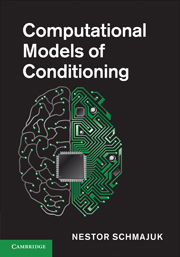Book contents
- Frontmatter
- Contents
- List of contributors
- Introduction
- 1 Evolution of attention in learning
- 2 The arguments of associations
- 3 The hybrid modeling approach to conditioning
- 4 Within-compound associations: models and data
- 5 Associative modulation of US processing: implications for understanding of habituation
- 6 Attention, associations, and configurations in conditioning
- 7 Computer simulation of the cerebellum
- 8 The operant/respondent distinction: a computational neural-network analysis
- Index
- References
2 - The arguments of associations
Published online by Cambridge University Press: 10 January 2011
- Frontmatter
- Contents
- List of contributors
- Introduction
- 1 Evolution of attention in learning
- 2 The arguments of associations
- 3 The hybrid modeling approach to conditioning
- 4 Within-compound associations: models and data
- 5 Associative modulation of US processing: implications for understanding of habituation
- 6 Attention, associations, and configurations in conditioning
- 7 Computer simulation of the cerebellum
- 8 The operant/respondent distinction: a computational neural-network analysis
- Index
- References
Summary
Abstract
This chapter considers associative solutions to “non-linear” discrimination problems, such as negative patterning (A+ and B+ vs. AB−) and the biconditional discrimination (AB+ and CD+ vs. AC− and BD−). It is commonly assumed that the solution to these discriminations requires “configural” elements that are added to the compound of two stimuli. However, these discriminations can be solved by assuming that some elements of each stimulus are suppressed when two stimuli are presented in compound. Each of these approaches can solve patterning and biconditional discriminations because they allow some elements, as the arguments of associations, to have differential “presence” on reinforced versus non-reinforced trials, and thus differential associability and control over responding. The chapter then presents a more specific version of one of these models, describing how interactions between stimuli, particularly the competition for attention, provide a mechanism whereby some elements are more suppressed than others when stimuli are presented simultaneously as a compound.
Most computational models of conditioning adopt associative strength (V) as the variable that tracks learning about the association between a conditioned stimulus (CS) or action and the reinforcing unconditioned stimulus (US). Many of these models make very simple assumptions about the arguments of associations – the CSs and USs themselves. For example, the Rescorla–Wagner model treats these stimuli as singular units such that, during learning, a single connection strengthens between the CS unit and US unit (Rescorla & Wagner, 1972; Wagner & Rescorla, 1972).
- Type
- Chapter
- Information
- Computational Models of Conditioning , pp. 53 - 70Publisher: Cambridge University PressPrint publication year: 2010
References
- 2
- Cited by



